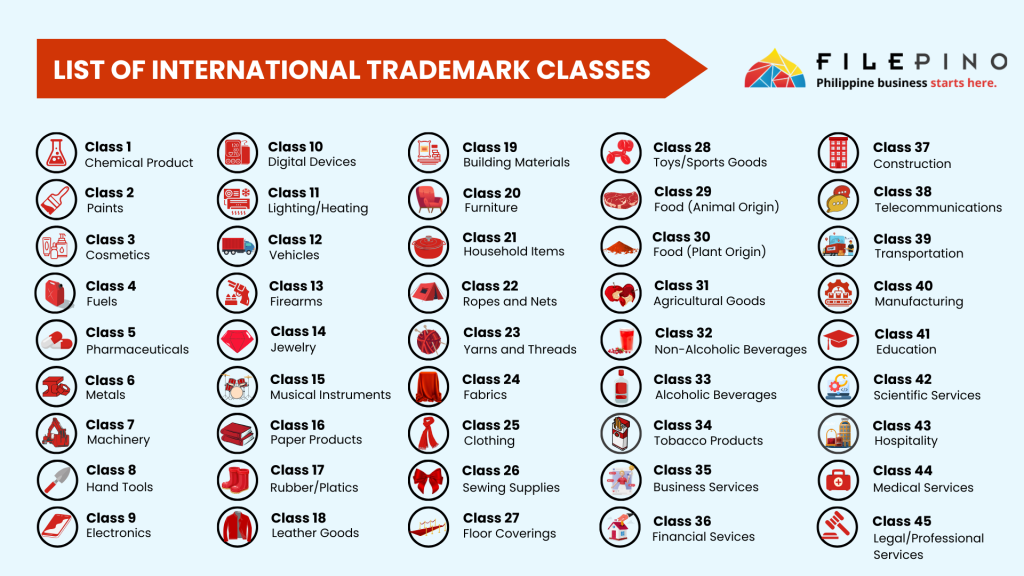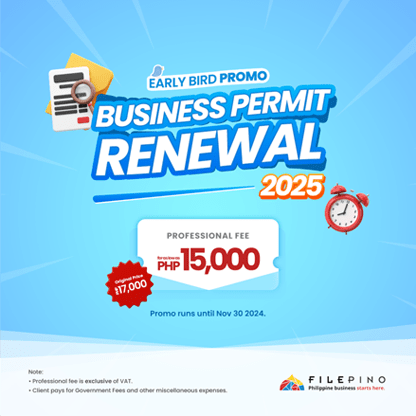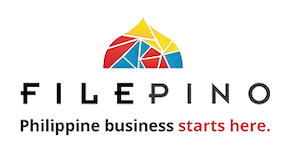Trademarks are essential for protecting your brand’s identity in the marketplace, and the International Trademark Classes (Nice Classification) play a crucial role in the trademark registration process. Established by the Nice Agreement (1957) and maintained by the World Intellectual Property Organization (WIPO), the system categorizes goods and services into 45 distinct classes. This ensures that trademarks are properly classified for their intended use.
Whether you’re registering a trademark for goods or services, understanding the classification system is vital. Below, we provide a comprehensive list of all 45 trademark classes along with their definitions.

What are International Trademark Classes?
Trademark classes organize goods and services into categories to simplify the registration process. There are:
- 34 classes for goods (Classes 1–34)
- 11 classes for services (Classes 35–45)
When filing a trademark, selecting the correct class(es) is critical. Each class provides protection for specific goods or services, so ensuring accuracy can help avoid conflicts or issues in registration.
How Trademark Classes Work
Trademark classes provide a framework for registering intellectual property. Here’s how they work in practice:
Goods vs. Services
The first 34 classes cover physical goods, while Classes 35–45 deal with services.
Overlapping Categories
Some goods or services can fall under multiple classes, requiring careful consideration. For example, software may fall under Class 9 (downloadable software) or Class 42 (software as a service).
Multi-Class Registration
Businesses often register trademarks in multiple classes to ensure comprehensive protection. For example, a fashion brand might register in Class 25 (clothing), Class 18 (bags), and Class 35 (retail services).
Goods
| Class | Category | Definition |
| 1 | Chemical | Chemicals used in industry, science, and agriculture (e.g., adhesives, fertilizers). |
| 2 | Paints | Paints, varnishes, and preservatives against rust and corrosion. |
| 3 | Cosmetics | Cleaning products, cosmetics, perfumes, and soaps. |
| 4 | Fuels | Industrial oils, greases, and fuels (e.g., candles, lubricants). |
| 5 | Pharmaceuticals | Medicinal products, dietary supplements, and disinfectants. |
| 6 | Metals | Common metals and their products (e.g., building materials, hardware). |
| 7 | Machinery | Machines, motors, engines, and agricultural implements. |
| 8 | Hand Tools | Hand-operated tools and cutlery (e.g., scissors, razors). |
| 9 | Electronics | Scientific instruments, software, and electronic devices (e.g., computers). |
| 10 | Digital Devices | Surgical, medical, and dental apparatus. |
| 11 | Lighting/Heating | Appliances for lighting, heating, and cooling (e.g., air conditioners, lamps). |
| 12 | Vehicles | Vehicles, their parts, and accessories. |
| 13 | Firearms | Firearms, ammunition, and explosives. |
| 14 | Jewelry | Precious metals, jewelry, and watches. |
| 15 | Musical Instruments | Musical instruments and accessories. |
| 16 | Paper Products | Stationery, books, and printed materials. |
| 17 | Rubber/Plastics | Rubber, plastics, and insulation materials. |
| 18 | Leather Goods | Leather goods such as bags, wallets, and umbrellas. |
| 19 | Building Materials | Non-metallic building materials (e.g., wood, glass). |
| 20 | Furniture | Furniture and items made of wood, plastic, or metal. |
| 21 | Household Items | Kitchen utensils, cookware, and glassware. |
| 22 | Ropes and Nets | Ropes, tents, and raw fibrous textiles. |
| 23 | Yarns and Threads | Threads and yarns for textile use. |
| 24 | Fabrics | Fabrics, linens, and curtains. |
| 25 | Clothing | Apparel, footwear, and headgear. |
| 26 | Sewing Supplies | Ribbons, buttons, zippers, and other haberdashery items. |
| 27 | Floor Coverings | Carpets, rugs, mats, and linoleum. |
| 28 | Toys/Sports Goods | Toys, games, and sporting equipment. |
| 29 | Food (Animal Origins) | Meat, fish, dairy products, and edible oils. |
| 30 | Food (Plant Origin) | Coffee, tea, bread, and spices. |
| 31 | Agricultural Goods | Live animals, fresh fruits, and seeds. |
| 32 | Non-Alcoholic Beverages | Sodas, mineral water, and juices. |
| 33 | Alcoholic Beverages | Alcoholic drinks (except beer). |
| 34 | Tobacco Products | Tobacco, cigars, cigarettes, and lighters. |
Services
| Class | Category | Definition |
| 35 | Business Services | Advertising, business management, and consulting. |
| 36 | Financial Services | Banking, insurance, and real estate. |
| 37 | Construction | Building, maintenance, and repair services. |
| 38 | Telecommunications | Communication and broadcasting services. |
| 39 | Transportation | Logistics, shipping, and storage services. |
| 40 | Manufacturing | Custom manufacturing and material processing. |
| 41 | Education | Training, education, and entertainment services. |
| 42 | Scientific Services | IT, research, and development services. |
| 43 | Hospitality | Food and drink services, hotels, and accommodations. |
| 44 | Medical Services | Healthcare, veterinary, and agricultural services. |
| 45 | Legal/Personal Services | Legal services, security, and social work. |
Protect your brand today with Filepino—your trusted partner in trademark registration. Contact us now to get started!
How to Choose the Right Trademark Class for Your Business
Selecting the correct trademark class is crucial to securing proper protection for your brand. Misclassification can lead to denied applications or inadequate safeguards. Here’s a streamlined guide to help you navigate this process effectively.
1. Understand Your Products and Services.
Start by identifying what your business offers—whether it’s products, services, or both. Consider current offerings and future expansions.
- Example 1: A clothing brand falls under Class 25 for apparel and may need Class 35 for retail services if it operates stores.
- Example 2: A skincare company in Class 3 (cosmetics) may expand into supplements requiring Class 5 (pharmaceuticals).
Plan strategically to protect both present and future opportunities.
2. Research Similar Trademarks.
Conduct a thorough search of existing trademarks to avoid conflicts:
- Check Trademark Databases: Look for registered and pending trademarks in your category.
- Focus on Classes: Ensure no overlap with similar names in your target classes.
Example: If “Green Leaf” sells organic teas, you’d search Class 30 (tea) and Class 32 (non-alcoholic beverages). A name can be registered across different classes, like “Lotus” for cars in Class 12 and yoga apparel in Class 25.
3. Consider Multi-Class Registrations.
If your business spans multiple categories, register across relevant classes to protect all aspects of your brand.
Examples:
- Amazon: Software (Class 9), online retail (Class 35), and streaming services (Class 41).
- Nike: Apparel (Class 25), sports equipment (Class 28), and retail stores (Class 35).
Multi-class registration offers comprehensive protection and accommodates future growth.
4. Avoid Common Mistakes.
Common Errors to Watch For:
- Too Narrow: Failing to register in related classes (e.g., beverages missing Class 30 and Class 32).
- Too Broad: Registering irrelevant classes (e.g., registering in Class 12 for vehicles when selling clothing).
- Ignoring Future Needs: Neglecting potential expansions into new markets or products.
Solution: Strike a balance by focusing on all relevant, realistic categories.
5. When to Seek Professional Help.
Trademark registration can be complex, especially for multi-class or international filings. Seek expert advice if:
- Your products/services overlap multiple classes.
- You operate in emerging industries with ambiguous classifications.
- You plan to expand internationally, where class interpretations may vary.
Benefits of Professional Help:
- Accurate classification.
- Avoidance of application errors.
- Long-term protection for your intellectual property.
Choosing the right trademark class is essential to securing comprehensive protection for your brand. By understanding your products and services, researching similar trademarks, and considering multi-class registrations, you can avoid common pitfalls and ensure your intellectual property is safeguarded. Whether you’re a startup or an established business, getting your trademark registration right from the start sets the foundation for long-term success.
If you’re unsure about which classes to register for or need professional assistance navigating the complexities of trademark law, Filepino is here to help. Our team offers expert guidance and comprehensive trademark registration services tailored to your business’s unique needs.
… and you might just need our assistance.
We, at FilePino, a one-stop-shop business consulting firm trusted by thousands of clients for their business formation and post-formation needs, offer a comprehensive trademark registration service in the Philippines.
With our sister company, Duran & Duran-Schulze Law, we guarantee that there will be an in-house team of lawyers and trademark specialists, who can provide you with accurate information and complete guidance throughout the trademark registration process.
Ready to register your trademark? Set up a consultation with FilePino today! Call us at (02) 8478-5826 (landline) and 0917 892 2337 (mobile) or send an email to info@filepino.com.









